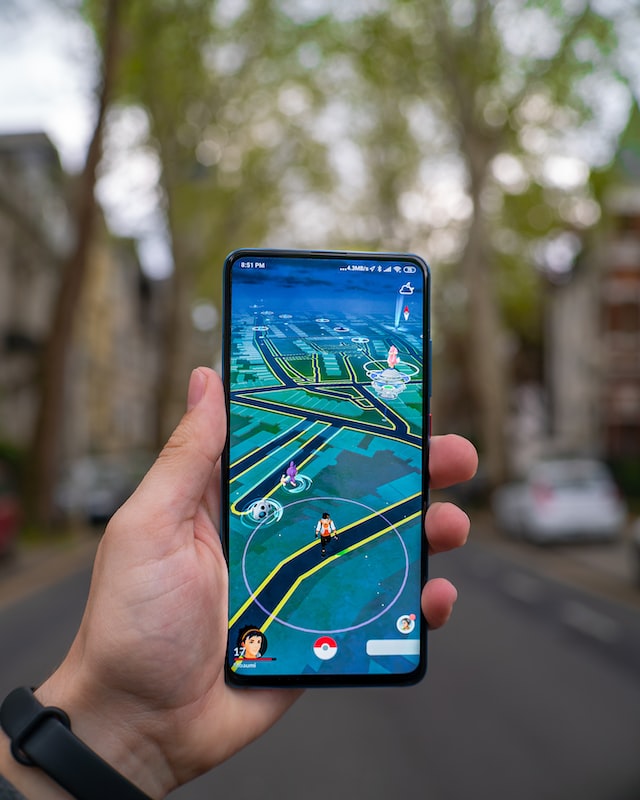Mobile Game App Development
The gaming industry has seen tremendous changes in recent years with an exponential increase in users. It has made the industry rake in more than billions in revenue. Thus, providing an immense opportunity in this space for game developers, marketers and mobile game development companies.
In particular, the year 2020, which will always be remembered as the year of the pandemic, decimated a large number of firms and sectors. However, the gaming sector thrived during the same disastrous year. With a huge turnout of $77.2 billion, it consequently seemed to be one of the highest performing industries globally in 2020. In addition, specialists in the gaming industry predict continued growth in 2021.
Hence, if you are looking to capitalize on this, you must carry relevant information regarding trends and technologies in the gaming industry. It will help you make smart decision and strategy, even in choosing the best game app development company.
Artificial Intelligence in Mobile Game App Development
Every business has been impacted by the technological breakthrough known as artificial intelligence, including the video game industry. Artificial intelligence (AI) is a tool that game creators can use to evaluate player behaviour and build cutting-edge technologies into their games. Artificial intelligence can be used by game designers to personalise each player’s experience based on how they engage with the game.
Additionally, AI-powered tools can assist in developing an algorithm that game creators can use to determine the optimal time to display in-app purchase options or adverts to a player. AI evaluation of these player in-game behavior enables developers to maximize profits without interfering with players’ gaming experiences.
AR & VR is the Superpower:
The possibilities in this planet are mind-boggling and magnificent. In the upcoming decades, the gaming industry will increasingly use augmented reality (AR) or virtual reality (VR). This is definitely going to happen, and the reasons why are fairly clear.
AR mechanics aid in integrating computer-generated aspects into the gamers’ actual physical surroundings. It has been employed by several gaming apps to introduce virtual creatures into the real world. Similar to this, spending more time with a VR headgear immerses the user in an alternate reality that seems real and entirely blocks out the real world.
AR / VR technology offers a more high-end gaming quality as users get to experience an utterly fictional world that seems real but happens virtually. Using this technology, developers can add more elegance and sophistication to their games.
Multiplayer Games
The gaming business has recently shifted more toward multiplayer games. Players enjoy playing in groups whether or not they know each other personally, hence this feature is more in demand. Multiplayer games are preferred by players because they offer a more immersive gaming experience. Many gaming apps also enable players to talk and share various emoji while playing, which makes the experience more dynamic.
As a result, creating multiplayer games may be more successful than creating apps for single-player gaming.
Integrate With Social Media Channels
Nowadays, social media has become a form of obsession, and the majority of them are only found here. As individuals enjoy playing games with their friends and family, integrating mobile gaming with social media is a rapidly expanding trend in the business.
On the other hand, game apps that let users invite friends to play through social media sites are probably going to see faster user growth.
As a result, creating mobile game apps that integrate social media tends to draw in a lot of players by enabling them to invite, share, and interact with their friends and family.
Final Words
Overall, the gaming industry has become a promising scope with fantastic growth. Stick to the market trends and technologies and integrate that into your mobile game apps to get the most out of them.
Webmobril Technologies, the best game app development company, can help you deliver exciting game apps designed with the latest technologies to cater to gamers’ expectations.
Stages of Game Development
A game development process typically consists of 5 main stages: pre-production, production, quality assurance, launch, and post-production maintenance.
Stage 1. Pre-production
The game development process should always start with proper planning, often ignored by many companies. It is essential to gather complete information about the requirements for upcoming products, such as technical aspects, specific features, etc. Managers and product owners define the goals and business of the project and create the roadmap out the core concept behind it.
This phase includes analysis of market, competitor and target audience, choosing a platform, resource allocation, strategies and risk calculation. Once requirement gathering completes, a comprehensive Game Design Document is created to proceed further with the production stage.
Stage 2. Production
Five Main Stages of Game Development
Games development is a complex process, and thus it takes a lot of effort to create a masterpiece. Every Game Development Company claims to offer imperative results, remember not all of them can offer the game production processes with a proper workflow and management.
Therefore, it is important to know about the entire stages of game creation, enabling you to organize and optimize your workflow.
So here, learn about game development stages and how to find a reliable partner for custom game development.
Stages of Game Development
A game development process typically consists of 5 main stages: pre-production, production, quality assurance, launch, and post-production maintenance.
Stage 1. Pre-production
The game development process should always start with proper planning, often ignored by many companies. It is essential to gather complete information about the requirements for upcoming products, such as technical aspects, specific features, etc. Managers and product owners define the goals and business of the project and create the roadmap out the core concept behind it.
This phase includes analysis of market, competitor and target audience, choosing a platform, resource allocation, strategies and risk calculation. Once requirement gathering completes, a comprehensive Game Design Document is created to proceed further with the production stage.
Stage 2. Production
This is the major and most-labor intensive phase of video game production divided further into several internal stages.
Prototyping
Prototyping is the initial stage of production wherein playtests of the main mechanics is built to use in the game. It requires artisans and huge investment to come up with a colossal product.
Visual content creation
The visual content is about everything a game is packed with — characters, props, environment, and game assets. This stage has a great impact on the time spent on creating a game and depends largely on the required format of the game, either 2D or 3D.
A 2d and 3d Game Development Company though put both formats in the same pipeline, but 2D visuals require less complex technology and time for flat visual content sketching, coloring, and animation. 3D games development, on the other hand, puts a lot of challenges and typically require going through stages that include polygonal modeling (creating a basic model using polygonal figures), sculpting, texturing, rigging, and animation.
This means the process is relatively faster and more straightforward in 2D games (however, it also depends on the detailing of the content). 3D games use advanced software and tools in addition to specialized skills and knowledge.
Game level design development
This is the crucial stage where the development of the logic of the game levels takes place, which differs for each genre. For example, increasing the difficulty levels on completing a linear quest.
In this level design stage, designers also develop game mechanics, game economy design, plot and handy details such as hints labelling new mechanics and leading a player through a game, along with building transitions between levels.
Audio design and voice acting
Audio is a vital part of captivating game design. In this stage, sound specialists create soundtracks and audio effects for different play situations. It includes special sound effects to signal danger, victory, defeat, etc.
Based on the concept of the game, some natural sounds are also added, like character steps, explosion, water or wind sound, etc. In case the characters need to be voiced, dialogue, monologue, and individual lines are recorded with the help of voice artists and integrated into the software.
Coding
Once all the elements in a game are ready, developers write numerous lines of code to combine all the content together, for which they often use game engines. The difficulty in this stage is in developing a game like a puzzle, not including mutually exclusive mechanics and running without errors and failures. Developers strive to consider all possible technical factors and create a positive user experience.
Stage 3. Quality assurance
After the production job finishes, and the game comes in its full shape, it needs to be tested to ensure it is bug-free and will function without error. No matter how complex a game is, testing for quality assurance is an inevitable process in line with successful game development. Even a minor bug can negatively impact the user experience and overall game experience. Mobile game development studios typically perform functional testing, non-functional testing, as well as Alpha and Beta testing.
Functional game testing types:
- Interoperability testing
- Regression testing
- Localization testing
- Smoke testing
- User acceptance testing
- Security access control testing
Non-functional game testing types:
- Load testing
- Performance testing
- Stability testing
- Stress testing
- Volume testing
- Usability testing
- Installation testing
- Configuration testing
- Compliance testing
- Disaster recovery testing
Alpha Testing: This is the final testing stage of a finalized game that is carried out when functionality, performance, compatibility, and other features are tested, and all the bugs are fixed.
Beta Testing: At times, Alpha testing is followed by Beta testing that does not include any technical or software tool. It is done by simulating players to find issues that end users may face while playing the game.
Stage 4. Launch
The most awaited stage of game development is the launch. Launching a game means to handover it to stores for players to buy or download. However, the process needs to be done precisely, taking into account the important terms & conditions of the particular app store.
Also, even when the game is ready, some errors still exists. Hence, the game development team continues to make improvements in the game in parallel to the launch.
Stage 5. Post-production
The story of a game production doesn’t end with the launch, it requires constant monitoring for the fixes and improvements to enrich the user experience. Professionals keep a check on the stability and performance and come with the regular release of updates. A game development company, usually update the content of the gameplay or add some exciting features and mechanics to keep users engaged.
Five Main Stages of Game Development
Games development is a complex process, and thus it takes a lot of effort to create a masterpiece. Every Game Development Company claims to offer imperative results, remember not all of them can offer the game production processes with a proper workflow and management.
Therefore, it is important to know about the entire stages of game creation, enabling you to organize and optimize your workflow.
So here, learn about game development stages and how to find a reliable partner for custom game development.
Stages of Game Development
A game development process typically consists of 5 main stages: pre-production, production, quality assurance, launch, and post-production maintenance.
Stage 1. Pre-production
The game development process should always start with proper planning, often ignored by many companies. It is essential to gather complete information about the requirements for upcoming products, such as technical aspects, specific features, etc. Managers and product owners define the goals and business of the project and create the roadmap out the core concept behind it.
This phase includes analysis of market, competitor and target audience, choosing a platform, resource allocation, strategies and risk calculation. Once requirement gathering completes, a comprehensive Game Design Document is created to proceed further with the production stage.
Stage 2. Production
This is the major and most-labor intensive phase of video game production divided further into several internal stages.
Prototyping
Prototyping is the initial stage of production wherein playtests of the main mechanics is built to use in the game. It requires artisans and huge investment to come up with a colossal product.
Visual content creation
The visual content is about everything a game is packed with — characters, props, environment, and game assets. This stage has a great impact on the time spent on creating a game and depends largely on the required format of the game, either 2D or 3D.
A 2d and 3d Game Development Company though put both formats in the same pipeline, but 2D visuals require less complex technology and time for flat visual content sketching, coloring, and animation. 3D games development, on the other hand, puts a lot of challenges and typically require going through stages that include polygonal modeling (creating a basic model using polygonal figures), sculpting, texturing, rigging, and animation.
This means the process is relatively faster and more straightforward in 2D games (however, it also depends on the detailing of the content). 3D games use advanced software and tools in addition to specialized skills and knowledge.
Game level design development
This is the crucial stage where the development of the logic of the game levels takes place, which differs for each genre. For example, increasing the difficulty levels on completing a linear quest.
In this level design stage, designers also develop game mechanics, game economy design, plot and handy details such as hints labelling new mechanics and leading a player through a game, along with building transitions between levels.
Audio design and voice acting
Audio is a vital part of captivating game design. In this stage, sound specialists create soundtracks and audio effects for different play situations. It includes special sound effects to signal danger, victory, defeat, etc.
Based on the concept of the game, some natural sounds are also added, like character steps, explosion, water or wind sound, etc. In case the characters need to be voiced, dialogue, monologue, and individual lines are recorded with the help of voice artists and integrated into the software.
Coding
Once all the elements in a game are ready, developers write numerous lines of code to combine all the content together, for which they often use game engines. The difficulty in this stage is in developing a game like a puzzle, not including mutually exclusive mechanics and running without errors and failures. Developers strive to consider all possible technical factors and create a positive user experience.
Stage 3. Quality assurance
No matter how complex a game is, testing for quality assurance is an inevitable process in line with successful game development. Even a minor bug can negatively impact the user experience and overall game experience. Mobile game development studios typically perform functional testing, non-functional testing, as well as Alpha and Beta testing.
Functional game testing types:
- Interoperability testing
- Regression testing
- Localization testing
- Smoke testing
- User acceptance testing
- Security access control testing
Non-functional game testing types:
- Load testing
- Performance testing
- Stability testing
- Stress testing
- Volume testing
- Usability testing
- Installation testing
- Configuration testing
- Compliance testing
- Disaster recovery testing
Alpha Testing: This is the final testing stage of a finalized game that is carried out when functionality, performance, compatibility, and other features are tested, and all the bugs are fixed.
Beta Testing: At times, Alpha testing is followed by Beta testing that does not include any technical or software tool. It is done by simulating players to find issues that end users may face while playing the game.
Stage 4. Launch
The most awaited stage of game development is the launch. Launching a game means to handover it to stores for players to buy or download. However, the process needs to be done precisely, taking into account the important terms & conditions of the particular app store.
Also, even when the game is ready, some errors still exists. Hence, the game development team continues to make improvements in the game in parallel to the launch.
Stage 5. Post-production
The story of a game production doesn’t end with the launch, it requires constant monitoring for the fixes and improvements to enrich the user experience. Professionals keep a check on the stability and performance and come with the regular release of updates. A game development company, usually update the content of the gameplay or add some exciting features and mechanics to keep users engaged.
Get a Flawless Game Development Services
Now when we are aware of the efforts it takes to create a game, you must understand that not all companies can bring effective results to the table. WebMobril Technologies is a leading unity and 2d and 3d Game Development Company that offers stunning and stress-free game development services. We have a team of experts who carries out every stage of building a game with utmost accuracy and industry knowledge.
If you have a concept for a game in any genre, WebMobril Technologies can effectively put it into action.












Add Comment